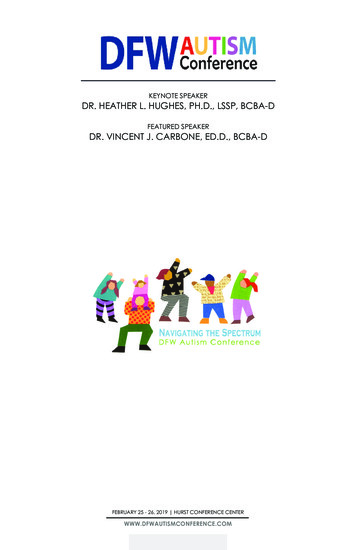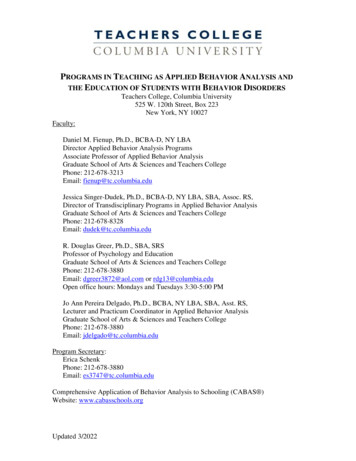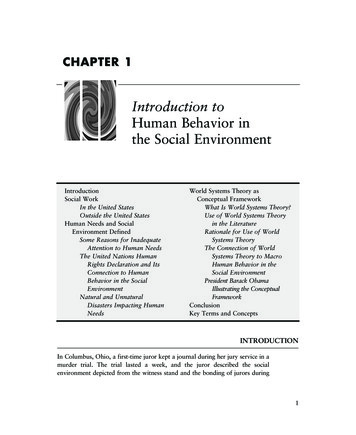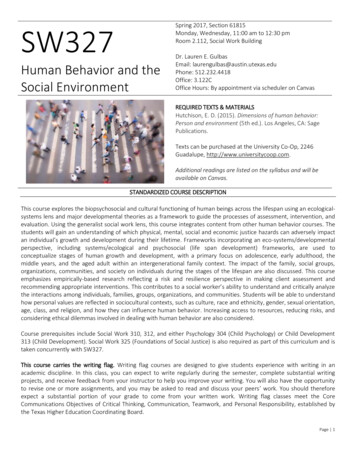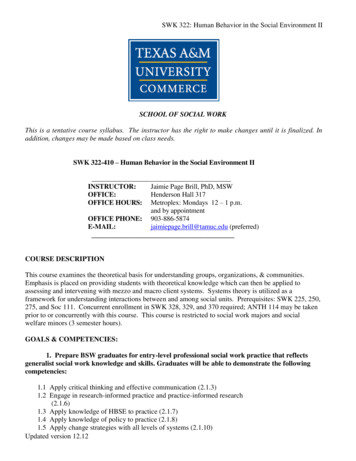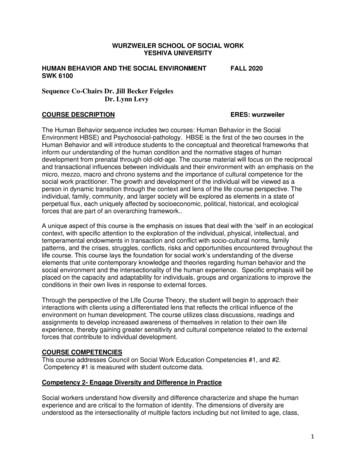
Transcription
WURZWEILER SCHOOL OF SOCIAL WORKYESHIVA UNIVERSITYHUMAN BEHAVIOR AND THE SOCIAL ENVIRONMENTSWK 6100FALL 2020Sequence Co-Chairs Dr. Jill Becker FeigelesDr. Lynn LevyCOURSE DESCRIPTIONERES: wurzweilerThe Human Behavior sequence includes two courses: Human Behavior in the SocialEnvironment HBSE) and Psychosocial-pathology. HBSE is the first of the two courses in theHuman Behavior and will introduce students to the conceptual and theoretical frameworks thatinform our understanding of the human condition and the normative stages of humandevelopment from prenatal through old-old-age. The course material will focus on the reciprocaland transactional influences between individuals and their environment with an emphasis on themicro, mezzo, macro and chrono systems and the importance of cultural competence for thesocial work practitioner. The growth and development of the individual will be viewed as aperson in dynamic transition through the context and lens of the life course perspective. Theindividual, family, community, and larger society will be explored as elements in a state ofperpetual flux, each uniquely affected by socioeconomic, political, historical, and ecologicalforces that are part of an overarching framework.A unique aspect of this course is the emphasis on issues that deal with the ‘self’ in an ecologicalcontext, with specific attention to the exploration of the individual, physical, intellectual, andtemperamental endowments in transaction and conflict with socio-cultural norms, familypatterns, and the crises, struggles, conflicts, risks and opportunities encountered throughout thelife course. This course lays the foundation for social work’s understanding of the diverseelements that unite contemporary knowledge and theories regarding human behavior and thesocial environment and the intersectionality of the human experience. Specific emphasis will beplaced on the capacity and adaptability for individuals, groups and organizations to improve theconditions in their own lives in response to external forces.Through the perspective of the LIfe Course Theory, the student will begin to approach theirinteractions with clients using a differentiated lens that reflects the critical influence of theenvironment on human development. The course utilizes class discussions, readings andassignments to develop increased awareness of themselves in relation to their own lifeexperience, thereby gaining greater sensitivity and cultural competence related to the externalforces that contribute to individual development.COURSE COMPETENCIESThis course addresses Council on Social Work Education Competencies #1, and #2.Competency #1 is measured with student outcome data.Competency 2- Engage Diversity and Difference in PracticeSocial workers understand how diversity and difference characterize and shape the humanexperience and are critical to the formation of identity. The dimensions of diversity areunderstood as the intersectionality of multiple factors including but not limited to age, class,1
color, culture, disability and ability, ethnicity, gender, gender identity and expression,immigration status, marital status, political ideology, race, religion/spirituality, sex, sexualorientation, and tribal sovereign status. Social workers understand that, as a consequence ofdifference, a person’s life experiences may include oppression, poverty, marginalization, andalienation as well as privilege, power, and acclaim. Social workers also understand the formsand mechanisms of oppression and discrimination and recognize the extent to which a culture’sstructures and values, including social, economic, political, and cultural exclusions, mayoppress, marginalize, alienate, or create privilege and power. Social workers apply and communicate understanding of the importance of diversity anddifference in shaping life experiences in practice at the micro, mezzo, and macro levels; Social workers present themselves as learners and engage clients and constituencies asexperts of their experiences; and Social workers apply self-awareness and self-regulation to manage the influence ofpersonal biases and values in working with diverse clients and constituencies.1. LEARNING OBJECTIVESAt the conclusion of this course, students will be able to:1- Demonstrate Ethical and Professional Behavior1. Social workers understand the value base of the profession and its ethical standards, aswell as relevant laws and regulations that may impact practice at the micro, mezzo, andmacro levels.2. Social workers understand frameworks of ethical decision-making and how to applyprinciples of critical thinking to those frameworks in practice, research, and policyarenas.3. Social workers recognize personal values and the distinction between personal andprofessional values. They also understand how their personal experiences and affectivereactions influence their professional judgment and behavior.4. Social workers understand the professional history, its mission, and the roles andresponsibilities of the profession.5. Social workers also understand the role of other professions when engaged in interprofessional teams.6. Social workers recognize the importance of life-long learning and are committed tocontinually updating their skills to ensure they are relevant and effective.7. Social workers also understand emerging forms of technology and the ethical use oftechnology in social work practice.8. Social workers make ethical decisions by applying the standards of the NASW Code ofEthics, relevant laws and regulations, models for ethical decision-making, ethicalconduct of research, and additional codes as appropriate in context.9. Social workers use reflection and self-regulation to manage personal values andmaintain professionalism in practice situations.10. Social workers demonstrate professional demeanor in behavior; appearance; and oral,written, and electronic communication.11. Social workers use technology ethically and appropriately to facilitate practice outcomes.12. Social workers use supervision and consultation to guide professional judgment andbehavior.2
13. Recognize and manage personal values in a way that allows professional values toguide practice.14. Make ethical decisions by applying standards of the NASW Code of Ethics.15. Tolerate ambiguity in resolving ethical conflicts.II. INSTRUCTIONAL METHODSLearning will occur through a variety of experiences including readings in theoretical andfictional sources, didactic lectures, films and class discussions. Class sessions are designed topermit exploration, not review, of the content assigned readings, and of the students'responses.III. COURSE EXPECTATIONS AND GRADINGStudents are expected to attend all classes and to be on time. Class participation is animportant part of the learning process and ALL students are expected to participate in allassigned exercises and discussions. Students are expected to complete assignments on time,complete readings and to be prepared for related class discussions. You will be graded on thedepth of your contributions and preparedness for class. In addition, all students must submit aweekly journal entry reflecting their reaction to assigned readings and class discussion. Eachassignment will be weighted as follows:10% Assigned readings in preparation for and participation in class discussions.15% First Written assignment- “Reflection on Environmental Influence On Early Development.”25% Quizzes and Reflective Journals25% Midterm: Written assignment-“Application of ecological perspective to a film”25% Final: Assignment-“Presentation on Stages of Development”Texts for the Course:Rogers, A.T. (2016) Human Behavior in the Social Environment: Perspectives on HumanDevelopment and the Life Course, 4th edition (paperback or rental online available). New York:Routledge. Cost: 53.52 (used), 59.50 (new), 20.86 (rental)ISBN-13: 978-1138819511ISBN-10: 1138819514Garbarino, J. (1992). Children and Families in the Social Environment, 2 edition. New York:Aldine de Gruyter. ISBN: 202-36080-6. Cost: 17.48 used.ndRecommended Texts:Newman, B.M. and Newman, P.R. (2018). Development Through Life: A PsychosocialApproach, 13 edition. Belmont, CA: Wadsworth Cengage Learning. ISBN: Student Edition:978-1-337-09814-4: Cost 112.97thThomas, A.J. & Schwarzbaum, S.E. (2017). Culture and Identity: Life Stories for Counselorsand Therapists, Third Edition. Los Angeles: CA. Sage Publishers. ISBN: 13: 978-1506305677 81.003
COURSE REQUIREMENTSASSIGNMENT I - Due Session 3 - Reflection on Environmental Influence On EarlyDevelopmentWe have introduced the various levels of the Ecological Perspective and the idea ofenvironmental press. This framework provides social workers with a useful tool forunderstanding some of the profound ways individuals are shaped by direct and indirectsystems. You were born into an environment that provided certain experiences, opportunitiesand challenges. Consider the environment of your early development (childhood years) and theways in which that environment influenced···How you think about yourselfYour current worldview – the lens through which you see the worldThe important relationships in your lifeThis is a 3-4 page reflective paper on how you understand the impact of the environment inwhich your childhood development occurred. Please be sure to consider micro, meso, exo,macro and chronosystems.Do not use literature or citations in this paper. (3) Due Date: 3 class. This paper isreflective, therefore the content is not graded. However, the paper will be evaluated on how wellyou have presented ideas in writing, organization of the paper and grammar (5) All papersmust be typed, double spaced. The cover page must be attached to the back of the paperso that the name of the writer is unknown until after the paper has been read.rdASSIGNMENT II- MIDTERM – APPLICATION OF THE ECOLOGICAL PERSPECTIVE TO AFILM.This assignment is a combination of demonstration of mastery of content as well as applicationof content to the characters/circumstances in the film. All written assignments requireunderstanding of theoretical concepts and materials presented in classroom and readings. Thispaper is an opportunity for you to apply what you have been learning this semester.You are required to view the film “The Boys of Baraka” on your own time prior to session 7this will be the basis of your midterm paper. The film is available on Netflix as well as on youtube however; on you tube you may need to sign-up to view it.1. Define Bronfenbrenner’s Ecological Perspective including all five (5) levels of systems –making note of each of the systems as they are expressed in the film.2. Choose two (2) of the main characters (among the “boys”).3. Through a multidimensional and life cycle perspective discuss how each system interactswith these characters to inform their functioning and development. Compare and/or contrast thedifferences or similarities between the environmental factors of these two characters.4. Make sure to include the environmental press, the interlocking circles of risk as well aselements of resource and resilience.4
5. Include any value conflicts and personal biases that may have emerged for you in viewingthe film.6. You may use any and all required readings as well as 4 additional peer reviewed journalarticles.This is an analysis not a film review. You are expected to apply acquired knowledge to yourunderstanding of the development of the characters you’ve chosen. Although you will focus onone character this paper is also about interlocking systems and the probable systemic impact onyour character’s development. Do not use online computer sites such as Wikipedia or sitesthat provide psycho-educational information. Use professional scholarly journals andtexts only!This paper should be presented in a scholarly fashion using APA-6 style citations andreferences. Make sure to include an Introduction and a Conclusion. You may use headingsto organize your paper if it helps. Number your pages. This paper should be 8-10 pages (NOMORE). Proofread your paper before submission. Due date: 9th session. LATE PAPERS ARENOT ACCEPTEDASSIGNMENT III – Presentation on Stages of Development: Due Date: Throughout thesecond half of the semester (Students should be assigned a stage by class 4)In this portion of the course students will teach the class about a stage of development asfollows:·In order to facilitate a productive experience for both the “teachers” and the class pleaseidentify two articles and send them to everyone, including your professor, at least one weekprior to the class you teach. Have three (3) questions for the class following your presentationthat will reflect both the readings and your presentation on the developmental stage that willstimulate a class discussion.·You will be asked to use a real or imagined case as part of your presentation. There arealso cases available in your textbook, but if at all possible, utilize a case from the field. Yourprofessor is available to meet with you to discuss the appropriateness of your case.The presentation should be approximately one hour, but may exceed that time. The followingis an outline of the areas that should be addressed in your presentation. Remember, you arethe ‘expert’.3.4.5.6.7.8.1. Describe the stage of Development and expectations for this stage, ie. thedevelopmental tasks (across biological, psychological, emotional, physical, spiritual)2. What is the psychosocial crisis, according to Erickson?What are the central themes during this stage of development?What are the basic strengths/virtues, or possible positive outcomes that may arise as aresult of the constructive resolution of this developmental stage?What are some of the major challenges individuals may face at this stage? Whatenvironmental risks do we need to be more cognizant of at this stage? How about familyrisks?What is the syntonic resolution/ the dystonic resolution?What are the new coping skill that result from the resolution of the crisis?How is this stage related to previous stages?5
a.b.What aspects of previous stages do we see playing out in this stage?How can the individual overcome issues that may have arisen as a result of a poorlyresolved psychosocial crisis?9. How is this stage related to later stages?a. What aspects of this stage might we see playing out in later stages?b. What may be expected if the psychosocial crisis is unresolved during in this stage?10. The impact of chronosystems on the experiences of this stage11. Utilize a real or imagined case study of an individual at this stage of development andaddress the following: (You may use yourself or a family member)a. Please describe the central themes of Life Course Theory and how they apply to theindividual and the circumstances.b. How can Life Course Theory be used to understand this stage of development?c. Are there any other theories that would be useful to us in understanding this individual atthis life stage? Please give examples, along with an explanation of why you have chosenthis theory why you believe it would be useful in your work with the client.12. Discuss the possible outcomes for the individual and his/her circumstance and anintervention that would help the individual resolve a psychosocial crisis during this life stage.You are welcome to include appropriate videos, small portions of film, role-plays, classexercises and other tools for engaging the class in discussion and creating a stimulatingclassroom experience. Students may work in pairs.All students must complete ALL class assignments, participate in class exercises, passboth midterm and final papers to receive a passing grade for the course. DO NOT makelast minute requests for special accommodations for completion of work; ifaccommodations are necessary this must be thoroughly discussed with the professorwith sufficient time to explore options and for the professor to plan.Competency 1- Demonstrate Ethical and Professional BehaviorCompetency Measures1A-Recognize and manage personal values in a way that allows professional values toguide practice.1B- Make ethical decisions by applying standards of the NASW Code of Ethics.1C- Tolerate ambiguity in resolving ethical conflicts.STUDENTS WITH DISABILITIESThe Office of Disability Services (ODS) collaborates with students, faculty and staffto provide reasonable accommodations and services to students with ces-and-Services/Disability-Services/The purpose of reasonable academic accommodations is to assure that there is equal access toand the opportunity to benefit from your education at Wurzweiler. It is the student’s responsibility6
to identify himself/herself to the Office of Disabilities Services (ODS) and to providedocumentation of a disability.Student Responsibilities Register with the Office of Disability Services (ODS).Provide current, written documentation from a qualified practitioner that describes thenature of the disability, functional limitations associated with the disability, severity of theselimitations, and recommended reasonable accommodations.Review accommodation requests with ODS.Submit accommodation letters to faculty and discuss reasonable accommodations at thestart of the semester.Communicate with faculty to arrange each exam accommodation at least ONE WEEKbefore the exam.File documentation with appropriate individuals to request accommodations for finalexam period.Alert the Office of Disability Services if any difficulties are encountered regarding theimplementation of accommodations.Getting StartedStudents in Yeshiva University who wish to receive accommodations must self disclose byregistering with The Office of Disability Services (ODS). ODS has established the followingprocess for registration: Complete an Intake form.Gather and submit current documentation of your disability.To register as a student with a learning disability or ADD/ADHD, you must submit acurrent psycho-educational or neuro-psychological evaluation. For all other disabilities you maysubmit documentation completed by a qualified health professional/clinician. Please refer toour Disability Documentation Guidelines and choose the one specific to your disability to use asa guide.After you have submitted the Intake form and disability documentation, ODS will behappy to meet with you to discuss reasonable accommodations and other supports available toyou at Yeshiva University.Each semester, you will meet with ODS to discuss accommodations for your coursesand any accessibility needs. You will be given accommodation letters to submit to yourprofessors.Accommodation letters must be submitted to your professors as soon as they are received.E-RESERVESAccess full text copies of most of the "on reserve" articles for a course from your homecomputer. You will need Adobe Acrobat to use this service. Your professor will provide you witha password. The link for e-reserves is http://yulib002.mc.yu.edu:2262/er.php. Most of thearticles mentioned in the curriculum are available on electronic reserve (E-reserves). You canaccess the full text articles from your home or from a university computer at no charge.7
Accessing E-ReservesFrom Canvas1. Go to your class Canvas page.2. Click the link “Library Resources & E-Reserves” (no password required)From Campus1. If you wish to access e-reserves from the library home page (library.yu.edu),2. Use “wurzweiler” all lower case, as the password.3. If you have problems accessing e-reserves, email: Stephanie Gross, Electronic ReservesLibrarian: gross@yu.edu or ereserves@yu.edu.From Off-Campus1.2.3.4.Go to the library’s online resources page: http://www.yu.edu/libraries/online resources.aspClick on E-RES; you will be prompted for your Off Campus Access Service login and password.Use “wurzweiler” all lower case, as the password for all courses in all social work programs.If you have problems accessing e-reserves, email: Stephanie Gross, Electronic ReservesLibrarian: gross@yu.edu or ereserves@yu.edu.Using E-Reserves1. Click on “Search E-RES” or on “Course Index,” and search by instructor's name, department,course name, course number, document title, or document author.2. Click on the link to your course.3. When the article text or book record appears on the screen, you can print, email, or save it todisk. To view documents that are in PDF format, the computer you are using must have AdobeAcrobat Reader software. You can download it FREE GIARISMAll written work submitted by students is to be their own. Ideas and concepts that are the workof others must be cited with proper attribution. The use of the written works of others that issubmitted as one's own constitutes plagiarism and is a violation of academic standards. TheSchool will not condone plagiarism in any form and will apply sanction to acts of plagiarism.A student who presents someone else's work as his or her own work is stealing from theauthors or persons who did the original thinking and writing. Plagiarism occurs when astudent directly copies another's work without citation; when a student paraphrases majoraspects of another's work without citation; and when a student combines the work of differentauthors into a new statement without reference to those authors. It is also plagiarism to usethe ideas and/or work of another student and present them as your own. It is NOT plagiarismto formulate your own presentation of an idea or concept as a reaction to someone else's work;however, the work to which you are reacting should be discussed and appropriately cited. Anystudent who can be shown to have plagiarized any part of any assignment in a course will8
automatically FAIL the course and will be placed on Academic Probation and will be referredto the Associate Dean for disciplinary action which may include expulsion. A student may notsubmit the same paper or an assignment from another class for credit. If students or facultyare concerned that written work is indeed plagiarized, they can use the following “plagiarismchecker” websites, easily accessible, and generally free on Google:www.grammarly.com/plagiarism sources/www.duplichecker.com/As a Wurzweiler student, maintaining good standing in the program is dependent ondeveloping and maintaining high standards of ethical and professional behavior. Studentsare required to adhere to the Code of Ethics promulgated by the National Association ofSocial Workers (NASW).HIPAAIn line with HIPAA regulations concerning protected health information, it is important thatyou understand that any case information you present in class or coursework will need to bede-identified. What this means is that any information that would allow another to identifythe person must be changed or eliminated. This includes obvious identifiers such as namesand birth dates but may also contain other information that is so unique to the person that itwill allow for identification, including diagnosis, race/ethnicity or gender. If diagnosis,race/ethnicity or gender is directly related to the case presentation, it can be included if it willnot allow for identification.FERPAWurzweiler’s policies and procedures are in lie with FERPA regulations. In accordancewith the provisions of the Family Educational Rights and Privacy Act of 1974, asamended (Section 438 of the General Educational Provisions Act, 20 USC 1232g), alsoknown as FERPA, the University has adopted policies to protect the privacy rights of its“Students” with respect to their “Education Records,” in each case as defined below.FERPA affords Students certain rights of access to their Education Records and limits9
disclosure to third parties unless the Student provides written consent. In certaincircumstances, disclosure is permitted without the Student’s permission.Course OutlineTheme I- Orientation to the Course: Beginnings, Change, the Multidimensional Approachand the Life Course PerspectiveSessions 1-2: Beginnings and change: Beginnings relate to the student and the client. Welive in a systemic society and we develop across a continuum informed by different experiences,values, relationships and the environment. Beginnings may include conflicts, anxieties, losses,excitement, struggles and aspirations; these inherent dimensions are organized and informedby our life experiences.Garbarino, J. (1992) Children and Families in the Social Environment, 2 edition, New York:Aldine de Gruyter Chapter 2-“The Ecology of Human Development” 11-34ndGolan, N. (1983). The nature of transitions and the change process, chapter 2 In PassingThrough Transition, The Free Press: NY pp.11-22 CLASSIC ERESRogers (2016) Chapter 1 - “Human behavior and the Social Work Profession (p.1-23)Stein, G.(1964) The Making of Americans, New York: Harcourt Brace & World, Inc. 40-49Wheelis, A. (1995) Goodbye mama in Levitz, L. (Ed) Reflections on Human Behavior in theSocial Environment, 2 edition, Copley PublicationsndSession 3: Broad Definition of Systems: Development as Change including generalsystems theory, role theory and the ecological perspectiveThe person in environment construct has been used as the foundation for developing a multidimensional approach. No one dimension of the person or the environment will tell the wholestory; it is the interaction of all the dimensions folded into the construct of the personenvironment relationship that tells the story. This story is told over time and within a specifictime period; understanding the importance of time helps us to understand the constant changesin the person-environment transactions.····Introduction of the Ecological perspectiveEnvironmental PressRadius of Significant RelationshipsLife Course PerspectiveRequired Readings:Garbarino: Chapter 1: Beginning at the end, or ending at the beginning? p.1-10.10
Rogers: Chapter 2: The person in the environment p.23-58.Theme II: Family as Social System: Sessions 4 & 5: Family is the basic social institution andthe primary social group the configuration of which varies from culture to culture. This unitexplores identity formation within the context of family, the impact of change (developmental,illness, immigration, loss etc.) in and on the family and the family as the mediating systembetween the individual and society. The individual and his/her family are interdependent yet thefamily exists within and is impacted by the community, the larger society and socio-historic timeperiod.Classroom Exercise: An exploration of your own family - details to be provided by yourprofessor.Required Readings:Garbarino Chapter 4: The Family as a Social SystemMetzger, J. (2008). Resiliency in children and youth in kinship care and family foster care. ChildWelfare, 87(6), p. 115-40. E-Res.Fox, A., Berrick, J.D., & Frasch, K. (2008). Safety, family, permanency, and child well-being:What we can learn from children. Child Welfare, 86(1), p.67-90. E-Res.Paquin & Bushorn. (1991, June) Family Treatment Assessment for Novices. Families in Society,pp. 353-359.Theme III- The Self in an Environmental Context, Trauma, Risk & Resilience: Sessions 6Identification and exploration of Bronfenbrenner’s ecological perspective of developmentprovides a lens through which we understand our clients. All systems have inherent risks anddevelopmentally we learn to negotiate the systems in spite of and because of the risks. Allsystems also include resources and the interaction between risks and resources help us todevelop coping skills, change and grow. This occurs through the process of response to stress,crisis and trauma experiences.Required Readings:Dewan, Shaila (2007) “Using crayons to exorcise Katrina” New York Times, 9/17/07Garbarino, J. (1992) Children and Families in the Social Environment, (2 edition). New York:Aldine de Gruyter. Chapter 3- “Socio-cultural Risk and Opportunity” 35-70ndGreene, R.R. (2008). Human Behavior Theory & Social Work Practice, (3 edition) NewBrunswick, New Jersey: Transaction PublishersrdChapter 9-“Social Construction” 232-270 ERES11
Chapter 11-“Risk and Resilience Theory” 315-342 ERESHerman, J. (1997). Trauma and Recovery, New York: Basic Books.Chapter 2-“Terror” 33-50 ERESChapter 3-“Disconnection” 51-74Chapter 5- “Child Abuse”Learning Theme IV –Individual Person as a SystemSession 7: Definition of the Person as a System Developing Through Different StagesIntroduction of the person as a system: Multiple Dimensions of a Person: Understandingthe different dimensions of a person from a bio-psychosocial perspective provides a way ofunderstanding development throughout the life span. The Eriksonian paradigm is an excellentexample of development over the life span.Choice and Will- Socio-cultural factors inform our identification and understanding of ourchoices and the capacity to exercise our will. The Biological Person: Biological factors mayrestrict and/or enable and circumscribe the parameters of human development and individualabilities. The Psychological Person: Cognition, emotions and affect are dynamic dimensionsof the personality. There is a special relationship between intelligence, coping and decisionmaking across the life cycle. In addition, ego capacities are the focal points of our psychologicaldevelopment. The Psychosocial Person and the Spiritual Person: The psychosocialperspective is a traditional social work perspective important in understanding human behavior.However, it is important to add to this the person’s spiritual understandings and yearnings Thisrefers to one’s search for meaning, purpose in life and the need to connect to others in theworld. It is a process and therefore, develops over time. This is particularly important inunderstanding the traumatic responses of people. .Required Readings:Bernstein, J, (1995) Taking Rachel Swimming in Levitz, L. (Ed.) Reflections on Huma
The Human Behavior sequence includes two courses: Human Behavior in the Social Environment HBSE) and Psychosocial-pathology. HBSE is the first of the two courses in the Human Behavior and will introduce students to the conceptual and theoretical frameworks that inform our understanding of the human condition and the normative stages of human





